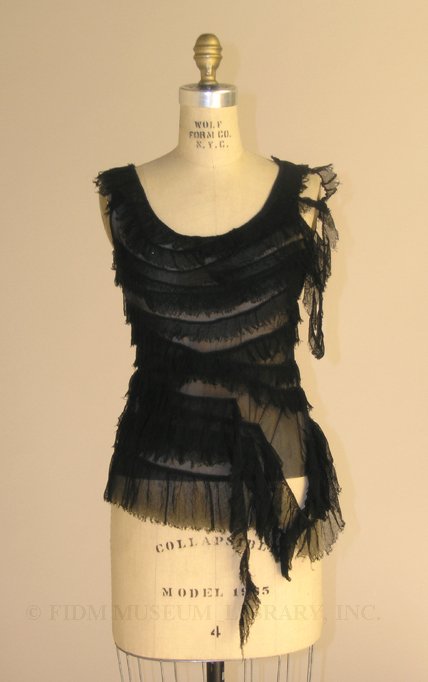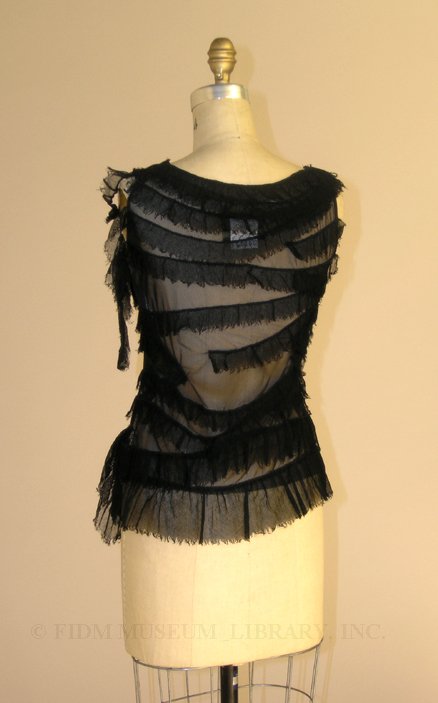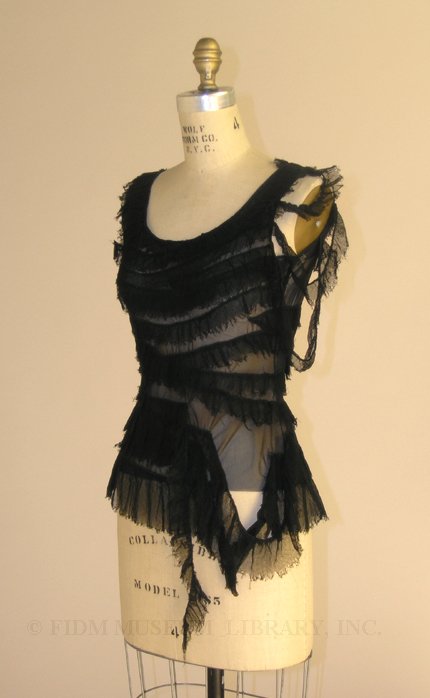These days, it’s fairly common to see garments incorporating raw edges, exposed seams and distressed textiles. Giving garments an unfinished appearance and hinting at the process of design and creation, this style is usually called deconstructionism. Initially intended to challenge widely held perceptions that garments must be flawlessly finished and enhance accepted definitions of beauty, these design elements have become so widely utilized that they’ve nearly lost the ability to shock and discomfort. Only extreme deconstruction can stop us in our tracks, such as the shredded and torn disarray of this Jean Paul Gaultier tank top. Though it appears to have been severely mistreated, this mesh tank was designed and manufactured to look tattered and torn.
Dear readers, does this deconstructed tank top inspire a strong reaction? Though it might not be as obviously appealing as our Madame Olympe or this 1930s evening coat, deconstructed garments play an equally important role in fashion history.
In a nutshell, deconstructionism is a philosophy based on uncovering contradictory meaning and therefore destabilizing the idea of universal truth. It is widely associated with the philosopher Jacques Derrida, who first proposed it as a way of thinking in the late 1960s. Though originating in the rarefied world of pure philosophy, ideals of deconstruction were soon applied to other areas of cultural practice, including architecture, music and fashion. In terms of fashion, this meant that some began to question long-standing perceptions of how clothing is constructed and its standing in relation to concepts of beauty. Though there have always been outliers who challenge perception, deconstruction allowed for a multiplicity of viewpoints on personal appearance and fashion to gain equal importance. Ultimately, it has resulted in the diversity of current styles that we see on the streets today.
Punk style, with its emphasis on worn and altered garments accompanied by a confrontational attitude, is probably the first example of deconstruction in fashion. British designer Vivienne Westwood began designing in this context and her work remains challenging to this day. During the 1980s, deconstructed garments appeared on Paris runways in the work of Japanese designers such as Yohji Yamamoto and Rei Kawakubo, who presented black and gray garments created of distressed and worn textiles that enveloped rather than accentuated the body. These garments were called obscure, complicated and intellectual, but were also widely influential. From these controversial origins, elements of deconstruction have become a widely accepted part of the fashion vocabulary, appearing on both mass-market T-shirts and fashion runways.






I suppose I’d react more strongly to it if it was worn by someone… on the dummy it looks more like an artistic artifact, so I’m rather admiring the fabric itself than wondering why it’s so tattered.
Although, when I look back at my comment, I probably should have left out the term “artistic” and replace it with something else, I’m not quite sure what – “finely crafted”? – because in the case of art it would more likely make me wonder.
Not that I want to decide what is art and what is not. I’m merely trying to describe my own reaction.
Deconstructionism allows the artist to see all of the “parts”, each just as important as the “whole”.
Hana, I think you pinpoint one of the problems with looking at garments off the body! Meant to be worn on a body, they sometimes don’t “read” quite right without the underlying human form. At the same time, it is sometimes easier to get a better sense of the intent of the designer without the distraction of a body. A troubling contradiction!
San D, good point. By breaking things down into their essential elements, it is sometimes possible to gain a better understanding of the whole.
i don’t like how the tag shows through the netting in the back. i suppose it would be de rigueur to REMOVE a label – something i do as soon as i purchase a garment, since they scratch the sensitive nape of my neck. that being said, i am fond of ripped seams, tattered and torn ribbon, faded leather, rusted metal… unintentional design in the making….
Hi Nina,
We typically leave all labels in the garments, as they are part of the history of that particular object. Often they include information, such as the date, that is helpful in contextualizing the object.
That said, I’m with you on removing labels from garments that I’m going to wear!
In the haphazard musings that come to mind when confronted with deconstruction fashion, well, when confronted with deconstruction anything, is the thought that if a garment has been “designed and manufactured to look tattered and torn”, then it wasn’t deconstructed. The so called deconstruction trend has hit fashion retail at all levels, from couture to the cheapest forms of mass production. No shock value left. On the other hand, the “modern” notion of up-cycling in fashion actually seems more in line with deconstruction. This synthesis process of taking something created by someone else and pulling it apart then putting it together in a new context, like creating a stunning couture wedding gown from old t-shirts and coffee cup filters, contradicts and destabilizes more than a garment that attempts to feed off a creative trend that belongs in an artist’s studio, not a manufacturing line.
Deconstraction fashion seems more like an art to me than a fashion trend. It looks good on a mannequin but I am not sure if it will give the same effect when worn by a person.